Denon AVR-S660H Reviewed at $499.00
Product Name: Denon AVR-S660H
Product Description: 5.2 CH 8K AV Receiver
-
Design - 9/10
9/10
-
Audio Quality - 8.8/10
8.8/10
-
Inputs / Ports - 9/10
9/10
-
OS, Apps and Features - 8.9/10
8.9/10
-
Price / Quality - 9/10
9/10
Summary
Reviewed at $499.00
Pros
- Good surround sound
- Full 40Gbps HDMI 2.1 ports
- Plenty of features
- Low price
Cons
- Not very powerful
- No front HDMI input
- Audyssey app not supported
- No backlight on remote
Cheapest Places to Buy :
*We are a reader-supported website. When you buy through links on our site, we may earn a small affiliate commission at no extra cost to you. Home Media Entertainment does not accept money for reviews.*
Dolby Atmos and DTS:X may be all the rage the last few years but there are more than a few consumers out there that a good old 5.1 channels surround system is more than enough for their entertainment. Either it be for budget reasons or limited space, not everyone can start placing Atmos speakers but this doesn’t make the surround experience of such a system less impressive or cinematic. So in our Denon AVR-S660H review today we are testing Denon‘s new budget friendly release that aims for exactly this market.
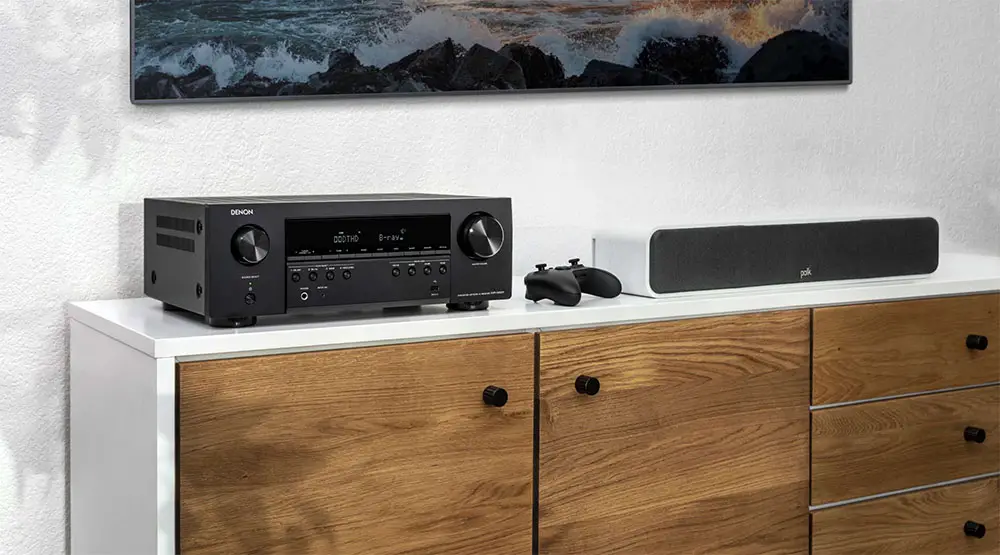
Having tested the AVR-S760H very recently, the step-up receiver of the AVR-S660H, we see that these two models have some obvious fundamental differences but also an awful lot of similarities. The major differences they have is that the S660H diches Dolby Atmos and DTS:X and instead supports the older Dolby TrueHD and DTS-HD Master Audio formats along with their appropriate up-mixing and virtual features. But except from that and the lower number of built-in channels available everything else seems to be remarkably similar. There are a couple more differences but we will talk about these in their appropriate section.
As for the S660H specifically, the receiver has 5.2 channels of built-in amplification with 75 watts of power per channel, supports the Dolby TrueHD and DTS-HD Master Audio formats along with the virtual and up-mixing tech in the likes of Dolby Pro Logic ll, DTS Neo:6 and Virtual Sound mode. It comes with the basic version of Audyssey called Audyssey MultEQ auto calibration system and comes with plenty of extras like High Resolution Audio, HEOS technology, AirPlay 2, voice control, custom integration as well as HDMI upscaling along with fully working HDMI 2.1 ports.
As was the case with the S760H, the AVR-S660H’s strongest selling point is no other than its three 40Gbps enabled HDMI 2.1 ports making this unit distinguish itself from the competition in the lower tier market of 5.2 channels AV receivers. This fact gives the edge to the S660H, when it comes to affordable gaming, and surely many consumers that don’t care much about Dolby Atmos will set their eyes upon Denon’s offer. So without further delay let’s see what we’ve got.
Design
Design wise the S660H is completely the same as the S760H both in terms of size and design. It seems that the shell of the S660H has plenty of space to accommodate the extra amplifiers of the S760H so there was no need to change anything. The only thing that gives it away is the less weight it has indicating the less hardware included.
As such the unit measures 17.1″ x 13.3″ x 8.5″ (434 x 339 x 215 mm) with the antennas in vertical position. You can slightly minimize its height to 6″ (151 mm) if you turn them horizontally without any loss of wireless quality and thus strikes a perfect balance between size and capabilities. The size of the receiver is just about what you should expect from its category so no real surprises here.
In real Denon fashion the outer shell is featuring straight lines and sharp corners as this is your typical black box receiver that sounds much better than it looks. The front features a brushed metal texture with an exact shame layout as most previous releases.
This means a big central display showing all functions with two big circular knobs at each side for volume on the right and source selection on the left. Under the source selection knob we find the power button while a thin line under the central display houses 10 function buttons that include tuner controls, Dimmer, Status, Info and Mode along with two groups of four circular buttons underneath with one group being the quick selection buttons and the other the sound modes.
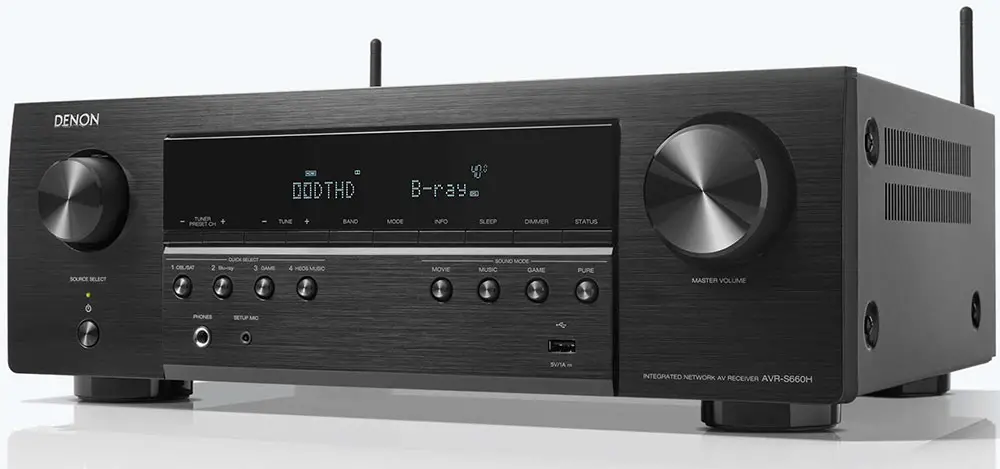
Under these buttons, as usual, we get the front ports with the headphones jack and setup microphone port on the left and a single USB port on the right that can be used to stream audio from a USB based external storage like a flash drive. The S650H was the only receiver that didn’t have a front HDMI port and the S660H seems to continue this trend so nothing is lost here.
When it comes to its internal hardware we don’t find much difference from other similarly priced Denon units either. The receiver features discrete high-current amplifiers on all channels with low-impedance drive capability while it’s 32-bit D/A converters allow for high resolution audio decoding while providing low distortion and the widest possible dynamic range.
The remote we find with this unit is code named RC-1243 and looks very similar to the RC-1244 that we saw with the AVR-S760H with the only difference being the missing Zone 2 button. The remote comes with all the input buttons at the top along with the HEOS and Bluetooth functions, navigation buttons in the middle along with channel and volume controls while playback, quick selection and sound mode buttons are being placed at the bottom.
The remote in general is a big one while the buttons have a relatively small size and we would like them a little bigger to be easier to the touch. At least the long distance between them minimizes the risk of a wrong command which can be a regular phenomenon in a dark environment since the remote lacks any kind of backlight functionality. Its construction is good and feels pretty solid with a nice texture on top to make it look a little bit more premium.

The AVR-S660H has pretty good build quality for its price and this surely has to do with Denon standards of manufacturing. You have to keep in mind what you pay for it and surely expectations cannot be sky high. But even like this the S660H passes with flying colors.
Audio Quality
The receiver does not support the latest Dolby Atmos and DTS:X and instead has to settle with the older Dolby TrueHD and DTS-HD Master Audio formats. This also affects the kind of up-mixing and virtual technology features included.
When it comes to up-mixing tech the receiver uses Dolby Pro Logic ll and DTS Neo:6. What these up-mixing tech are doing is to up-convert stereo and legacy mixes in order to make use of all the speakers you have in your setup. As for virtual tech the Virtual Sound mode is capable of creating sounds that originate from virtual created speakers around your room where there are no physical speakers present.
This virtual tech obviously is not as good or accurate as having real physical speakers and are very much room dependent. Also the sound many times can be heard very over-processed something we were never very fond of. But obviously some people may like it so it is never bad to include these.
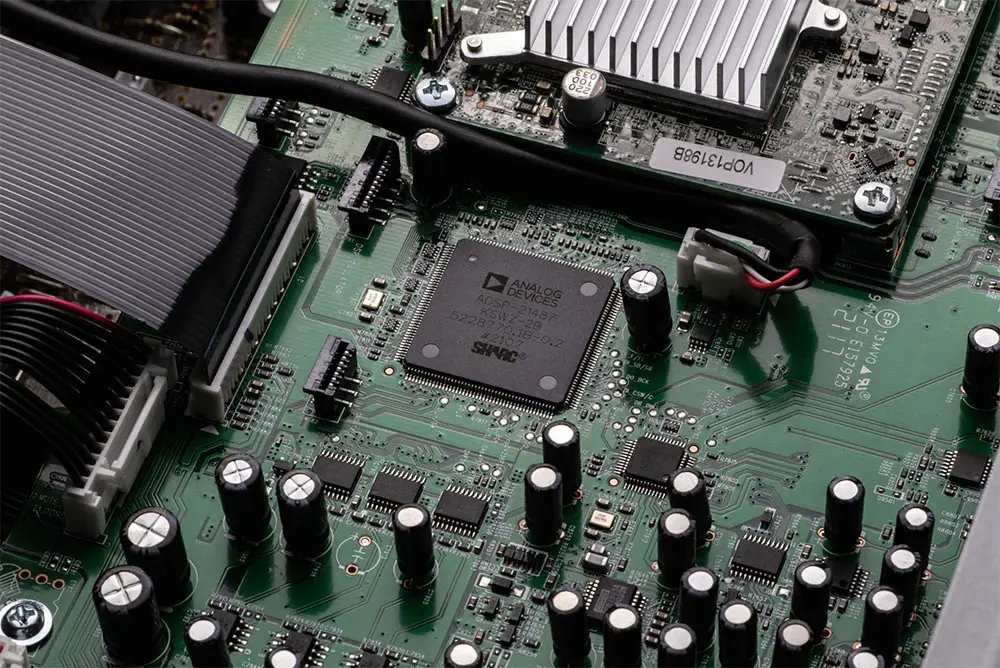
Being an entry level unit, part of the S-series, the AVR-S660H comes with 5 channels of built-in amplification and each channel can pump 75 watts of power (8 ohm, 20 Hz – 20 kHz, 0.08% 2ch drive). As always you should not be fooled by this number as manufacturers always give ratings with only 2 channels driven meaning that when all 5 channels are active this number goes down considerably.
With the supported channels you cannot do anything more than a basic 5.2 channels surround system but this surely doesn’t make the experience any less exciting. For this review we used a single SVS SB-1000 Pro subwoofer that was placed in the front left corner of our testing area.
The film we opted to try with this one was Greyhound which is streamed through Apple TV. It features a Dolby Atmos track that is delivered through the Dolby Digital Plus codec but since the receiver cannot do Dolby Atmos we were limited to the Dolby Digital Plus format.
Obviously for someone that is used to constantly hearing Dolby Atmos mixes the change to a simpler 5.1 channels setup will feel like something is missing but this should not make you believe that the S660H cannot create an immersive atmosphere even with the lower number of speakers available.
The front soundstage was expansive and full of energy, the center channel kept the dialogue contained at the middle and separated from the rest of the audio effects while surround effects and over-the-shoulder action blended nicely with the front speakers. The subwoofer did miracles when Greyhound throwed all its ordnance to the U-boats making the whole atmosphere tense and electrifying.
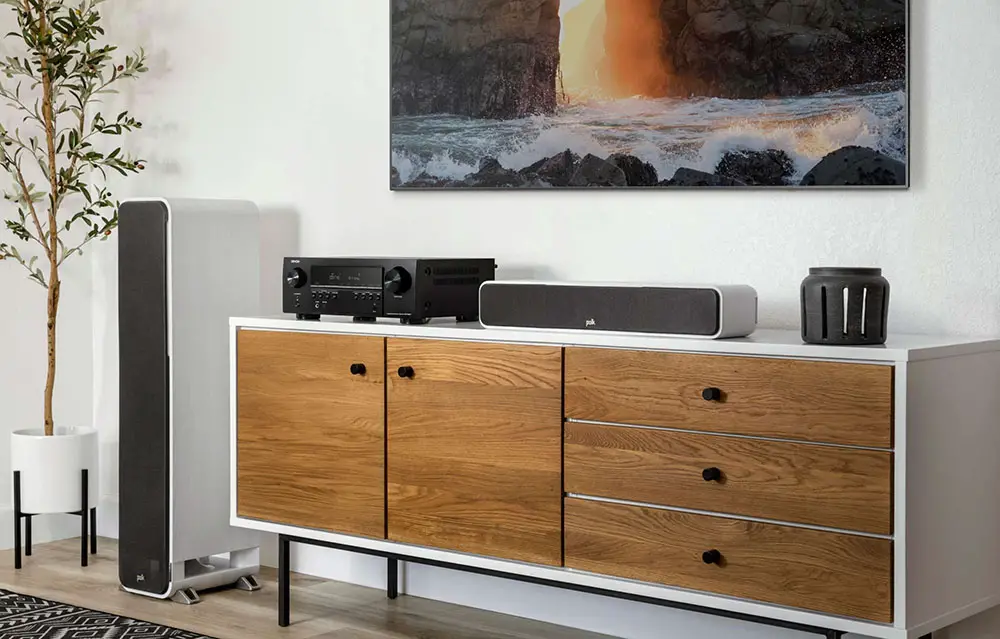
The receiver was very capable at rendering the naval battles and every bit of detail was clear and of high quality. Effects like the waves splashing on the metal body of the destroyer, weather effects like rain and thunder or even the ambience of the deep waters when the U-boats were stalking the convoy had exceptional quality and accuracy.
The overall immersion bubble felt more constraint mostly due to the missing overhead layer but the ear level action was top notch and even with only 5 channels most of the information would translate nicely to our room with pinpoint precision.
Next we tried Jurassic World and here we were greeted by an amazing DTS-HD Master Audio mix. Everything this track has to offer is on another level with an astounding level of balance and change of pace whenever was needed. Once again the Denon had no problem whatsoever rendering even the tinniest of details. Atmospheric sounds and ambient effects were all present and pronounced while in many of the jungle scenes there was a great sense of directionality with various sounds coming from all available speakers.
Low end action never disappointed with good weight and enough power to rock your room without losing cohesion or feeling muffled. Dinosaur roars had a nice raw tone while every time one of the bigger ones would step into the scene its footsteps would bring chills up our spines.
With the five available channels the S660H may loose a bit in overall accuracy but it was still impressive and certainly satisfying. So if you are planning to use this receiver for movies rest assured that it will give you what you are looking to get out of it.

Naturally High Resolution Audio couldn’t be missing so except from the usual low quality MP3, WMA and AAC the receiver can also playback FLAC, ALAC and WAV files up to 192 kHz / 24-bit as well as DSD for both 2.8 and 5.6 MHz. In our case, as we always do in our reviews, we selected a few music tracks in FLAC format that we streamed through the USB port of the receiver for the best possible quality.
And for that we switched to a 2 channels setup which is mostly preferred when listening to music. As we always say it is not only a matter of how good the AV receiver is but also with what kind of speakers you are going to pair it with in order to get the best of results.
In terms of audio quality and sound output the S660H was not all that different from the recently tested S760H and what we said in that review mostly applies here also. Overall performance was more than satisfying with probably our only gripe being its slightly less than stellar performance when pushed to its limits. It was then that the Denon lost some of its balance and compression artifacts started to show their ugly face.
But this shouldn’t be of huge concern as most of the time the receiver will perform at its best and since this is not a receiver that is meant to be pushed beyond its normal capabilities its casual users will surely enjoy its output and music resolution.
We tested it by trying various genres to get a better idea of its behavior with tracks including electronic, heavy metal, Jazz and some rock performances and from what we heard the Denon didn’t deviate much from its signature output. It may not blow your mind but on the other hand it doesn’t disappoint either.
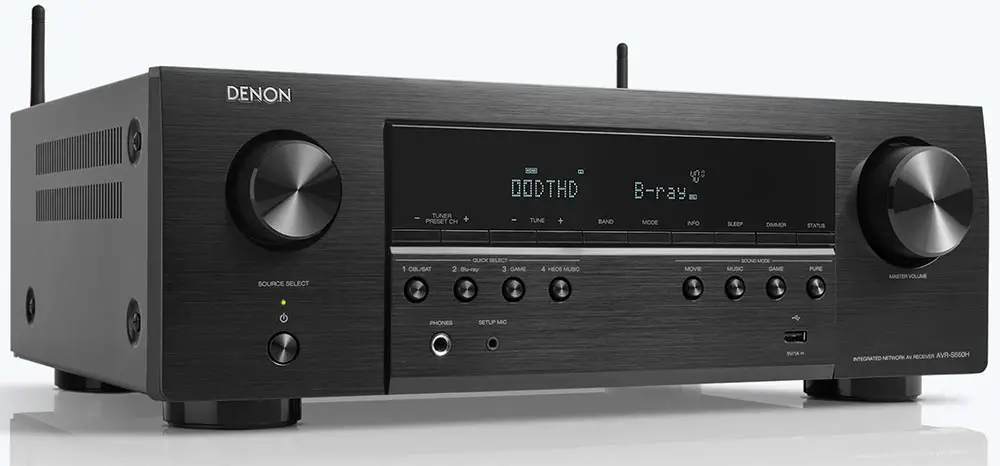
The mids were nice textured and tightly controlled, the high end had good energy and nice vibrancy while the lows kept the tempo going, they never felt loosing the rhythm and never struggled to follow. It will not be the kind of performance that will be remembered but surely it’s the kind of audio output that will relax you and enjoy the time you are given with it.
The AVR-S660H is a great example of a budget AV receiver. Its quality is up there with some more expensive units but at the same time its price makes it an affordable solution no matter what you plan on using it for. Either it be movies, music or video games the S660H will not disappoint and will put your limited money in good use.
Ports and Connectivity
Next we will be looking at the ports available. First of all we already mentioned above about the frontal ports that include the Headphones jack, the setup microphone port and the USB port.
At the back of the unit the first thing that catches the eye are the 5 speaker terminals placed in a straight line at the bottom which helps a lot with cable management. The terminals are the usual quality we have seen from Denon so all is good here with good quality plastic caps while each terminal has its own amplification.
At the top we find the HDMI inputs and here we find six of them instead of five on the S650H. But not only HDMI ports increased by one but also three of them are full HDMI 2.1 enabled.
As for the rest of the connections we get the same 2 composite video inputs and 1 output, 2 optical and 1 coaxial digital inputs, 1 Ethernet port, 0.2 channels pre-outs, 2 analogue audio inputs and one more dedicated for phono and the usual FM/AM antenna inputs along with the WiFi/Bluetooth connectors. The difference here compared to the S650H is that Denon has added a coaxial digital input which was missing before.
So in total the AVR-S660H has one more HDMI port along with one coaxial digital audio input compared to its predecessor.
As for the three HDMI 2.1 ports these support all the old and new exciting technologies including 8K/60Hz and 4K/120Hz video passthrough, 40Gbps bandwidth, 4:4:4 Pure Color sub sampling, HDR10, HDR10+, Dolby Vision, Hybrid Log-Gamma (HLG), Dynamic HDR, 3D, BT.2020 pass-through, Quick Media Switching (QMS), Variable Refresh Rate (VRR), Auto Low Latency Mode (ALLM) and Quick Frame Transport (QFT).
What is impressive is the fact that the AVR-S660H comes with the new unaffected HDMI 2.1 ports. All the 2020 AV receivers that featured HDMI 2.1 ports came with a bugged Panasonic chip that wouldn’t allow it to pass certain signals, like 4K/120Hz RGB signals from the Xbox series X for example as it would result in a black screen.
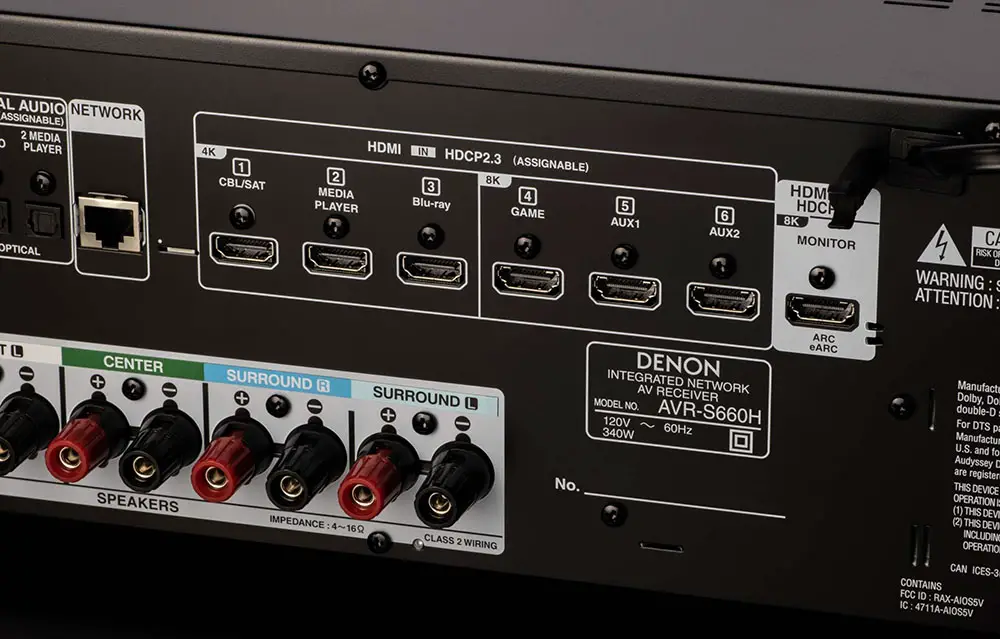
The AVR-S660H on the other hand seems to be using an updated version of this HDMI 2.1 chip which allows up to 40Gbps of bandwidth in three of its HDMI ports and this includes all the signals with a 4K@120Hz configuration including Xbox Series X.
Since the PS5 was unaffected even with the bugged HDMI 2.1 AV receivers we used an Xbox Series X to confirm if the S660H could indeed pass its signal to a TV and as was the case with the S760H recently we had no problems whatsoever here. No black screens, no artifacts and no disconnections.
As for the unit’s wireless capabilities we get built-in WiFi which can connect both in 2.4GHz and 5 GHz networks while it also supports Bluetooth streaming. The AVR-S660H supports Bluetooth 4.2, as most Denon receivers, it would be nice to have Bluetooth 5 at least but Denon still lags behind competition with this.
The AVR-S660H’s major strength is its three 40Gbps HDMI 2.1 ports and to be honest these are what most people will be using nowadays. It’s nice to have a number of legacy ports also but these are slowly go away which we totally agree with. And for the price you pay the S660H is an excellent value for money unit.
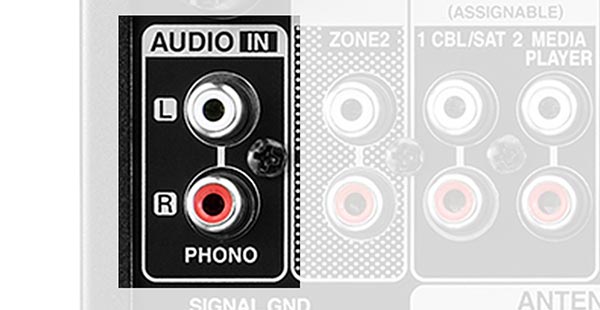
OS, Apps and Features
When it comes to extra features the S660H is extremely similar to the higher tier S760H with only two small differences that we will mention further down the article.
First of all we will talk about the audio calibration system. Denon is using the Audyssey system and as with all manufacturers they scale it accordingly to meet the price and performance standards of each of their models. The AVR-S660H is using the most basic version called the Audyssey MultEQ which is a step lower than the more advanced XT version found in the X1700H. In comparison this one features lower resolution filters which can result in less accuracy.
The Audyssey MultEQ comes also with Dynamic Volume and Dynamic EQ. Dynamic EQ is a feature that is responsible for keeping the clarity and dynamic levels of audio even when you like to watch at low volume, like for night viewings for example. Dynamic Volume on the other hand is capable of balancing sudden changes and spikes in volume that could appear when there are sudden changes from TV broadcasting to commercials.
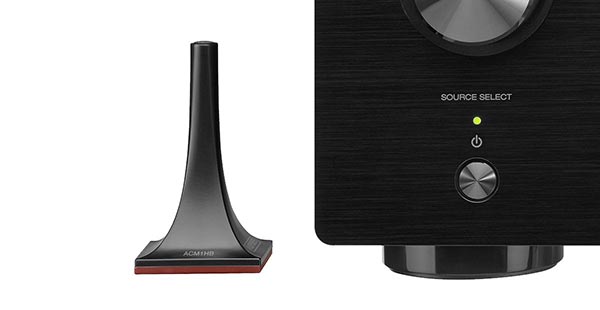
Going through the Audyssey calibration can be done with the built-in wizard and there are simple instructions on screen that you follow step by step to completion. And here we find the first difference as the S660H seems to be the first AV receiver that doesn’t support the Audyssey MultEQ Editor app and so you cannot do more advanced calibration of the system. But to be honest for such a low cost model we wouldn’t expect otherwise. After all the built-in system is more than enough for most casual users as it offers almost anything you need to make very good and precise adjustments to your system.
At least you can still use your mobile device as a remote through the appropriate app. The Denon 2016 AVR Remote app as it is called lets you control the unit with your mobile device through a nice visual interface. If you are tired of the included remote this is a nice and most important free alternative. The app is available for both Android and iOS devices so we suggest you give it a try to see if you like it.
When it comes to the User Interface the one in this unit is pretty simple and straightforward and similar to what we had seen in other Denon receivers so no surprises here either. Although it doesn’t have the visual impact of some other UIs we have seen used in TVs for example it’s layout is very nicely done and you can find all the settings you will need without much effort.
The receiver comes with the usual streaming as well as multi-zone capabilities that Denon includes in almost all their units. As it supports both HEOS and Airplay 2 you can either stream music online from one of the available online streaming services that include Spotify, Pandora, Amazon Music HD, TuneIn, SoundCloud, SiriusXM and TIDAL among others or create your own multi-room environment with the use of appropriate wireless speakers.
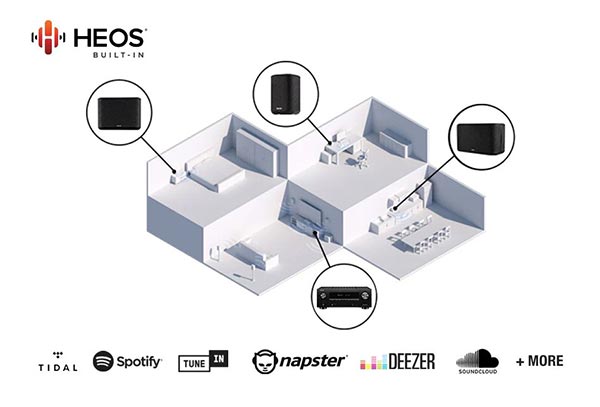
Both the HEOS and Airplay 2 apps are available for downloading from their appropriate stores for use with your mobile device. The receiver is missing Zone 2 and this is the second difference we find compared to the S760H and so this unit does not allow to connect speakers to a second room with wires.
Now as far as streaming, online is not the only option you have as you can stream audio from a network drive or NAS server if it happens you to have one connected to your local network. Also with the included USB port you can stream music through some connected external storage or flash drive. Lastly if you prefer a more wireless way of streaming your music there is Bluetooth available for connecting with your mobile device. If you use Apple devices then Airplay 2 can also be used to stream music wireless through it.
And since we mentioned Bluetooth another function that is included in the S660H and seems to have become a standard nowadays is that the receiver can output audio in two different ways using its Bluetooth transmitter. The S660H is capable of streaming audio to Bluetooth enabled headphones for a completely silent house experience or it can also output sound from both its speaker terminals and to a Bluetooth headset. This can be particularly practical in case there is a member in the family that is hearing impaired.
Denon is known for including all known voice control platforms to most of their models and the S660H is not any different in this regard. As such there is support for both most known ones with Amazon Alexa and Google Assistant but there is also support for Apple’s Siri through the Airplay 2 app and the advanced automation system Josh.ai making this receiver complete in every way.
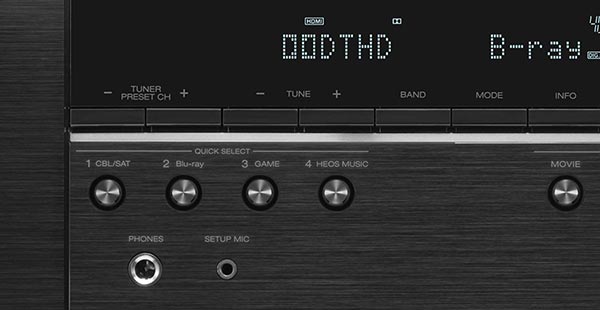
Another handy feature that we do find is HDMI-CEC and this one lets you use the TV remote to control the AV receiver if the TV also supports this. You can understand the practicality of this as this way you can reduce the amount of remotes you will need to have in your home theater. Obviously this feature lets you use only the most basic functions of the receiver but for everyday use it can be a very time saving one.
But extra features don’t end here so let’s see what else is included. The receiver supports video upscaling to 8K resolution but the limitation here is that the S660H can do that only through its HDMI ports and not from analog to HDMI. We also get an ECO mode that can regulate the receiver’s power usage for a more environmental friendly power consumption, custom integration for Domotz Pro and OvrC as well as being “Roon Tested” certified.
For this last one there seems to be a bit of confusion as there are two types of certifications. Roon Ready and Roon Tested. The AVR-S660H, as with most other similar receivers like Marantz, is Roon Tested which means while Roon will work on this unit you will not get the highest quality possible. So for example if you use Airplay, audio quality is limited to 16 Bit/44.1kHz. Keep that in mind in case Roon is specifically important to you but also want your files to be streamed in their original quality.

Final Thoughts
We all love the latest and greatest in sound design and output but there is a huge market out there that still seeks a good old 5.1 channels surround system to get their usual cinematic fix. And the AVR-S660H is more than enough to cover these basic needs at a cost that is affordable by most. The S660H is also a great gaming centric AV receiver and can do more than enough for the latest generation of gaming consoles.
There are so many things to like in the S660H. Build quality has the Denon name all over it, audio output is as good as it gets from an AV receiver of this category, it comes with plenty of extras and online features and the HDMI 2.1 ports gives it an edge compared to other 5.2 channels receivers in the market today. And for a price of $499 it can be a perfect addition to your video games entertainment room.
As for its downsides, we cannot say that at this price and this category the S660H had any major issues really. Obviously its power output was not the most bombastic and it will run out of juice in a big room pretty fast. Also we hated that there is no front HDMI which is very practical for easy connecting another device. The receiver does not support the Audyssey app so the built-in wizard is all that you have while we would definitely love to have a backlit remote because trying to press the correct button in the dark can be such a frustrating process.
Closing our review we can say that we were pretty satisfied with what this little AV receiver managed to offer. The Denon AVR-S660H can be the heart of a budget surround system that can perform equally good both in movies and video games and if you don’t care much about Dolby Atmos and the likes and if you have a relatively small living room or entertainment area then it will surely offer you an amazing cinematic experience.

For more reviews you can check our dedicated 5 channels 8K AV Receiver reviews list or even look at our Product Reviews Table where you can find the brand and specific product you are looking for.
Cheapest Places to Buy :
*We are a reader-supported website. When you buy through links on our site, we may earn a small affiliate commission at no extra cost to you. Home Media Entertainment does not accept money for reviews.*
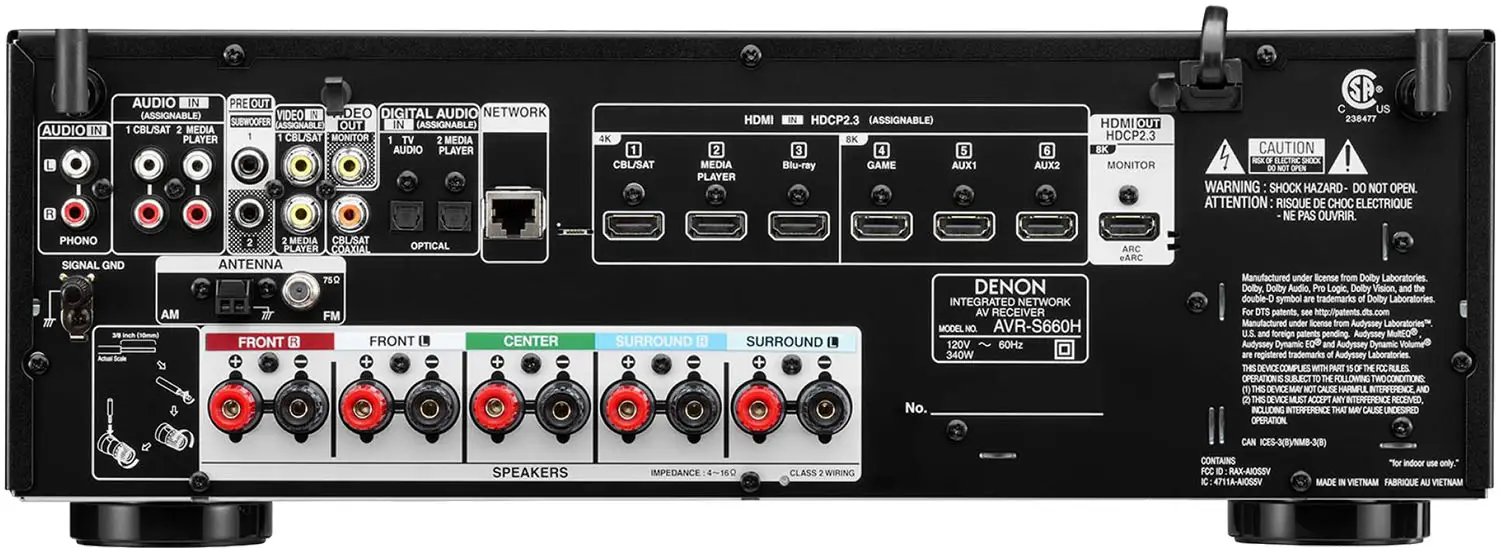
I don’t care about Atmos as I wouldn’t be able to add more speakers anyway. It seems that Denon is the first to offer such a cheap HDMI 2.1 receiver. I will wait a bit more to see where prices will go in this price range but the S660H surely is at the top of my list right now.
At this price you are not going to find another 5.1 channels, HDMI 2.1 enabled AV receiver, for sure. My suggestion is to go for it as it can be some time before another one will be able to compete at this category.
I have been in the Denon bandwagon for many years now and I was never disappointed. I was looking for a cheap model for my gaming room but with the bugged HDMI 2.1 models that came in the last two years I was afraid to pull the trigger. The S660H seems to be exactly what I was looking for. Thanks for such a detailed review. The best I have seen online.
Hello Lee. I would agree that the S660H is an excellent low cost solution for a gaming setup. It will surely find a lot of success among gamers.
Hi, i’m Italian, i love your reviews, sorry for my bad Italian. Between the Marantz 1510 and this Denon wich would you recommend? For Little rooms, but with good stereo sound. I listen alot of music (classical, jazz) not only movies. Can’t have alot of Power because of our neighbors. Near to get Polk audio R100 or Elac debut reference and the sub b&w asw608
Hello Santo and thank you for your kind comment. Well, the S660H is definitely the better AV receiver. It has more power and supports HDMI 2.1. The NR1510 on the other hand has the slim factor. Keep in mind that more watts means more than just higher volume. So personally if I could fit the S660H I would go for that one.
Thank you so much, really kind. Now Denon made the new Avr s670h, is it very different from the s660? What about the Onkyo 5100 or 6100 in Italy the difference in price is little with Denon avr s670. For me is more important the stereo sound than the 5.1 or 7.1.. Thanks so much for your kindness and patient. I actually have an old (but sounds really great) Pioneer vsx lx-53, i’m trying to sell it cause missing 4k support and other little things, any way to save it with pre av receiver connected to it? Thank you
Hello Santo. We are planning to review the two new Denon AV receivers (S670H and S770H) soon so if you make a little patience you will be able to read our thoughts and verdict on them. Obviously until then I cannot tell you much other than what I see on the specs. But I prefer not to say much on equipment that I do not personally test.
Thanks alot